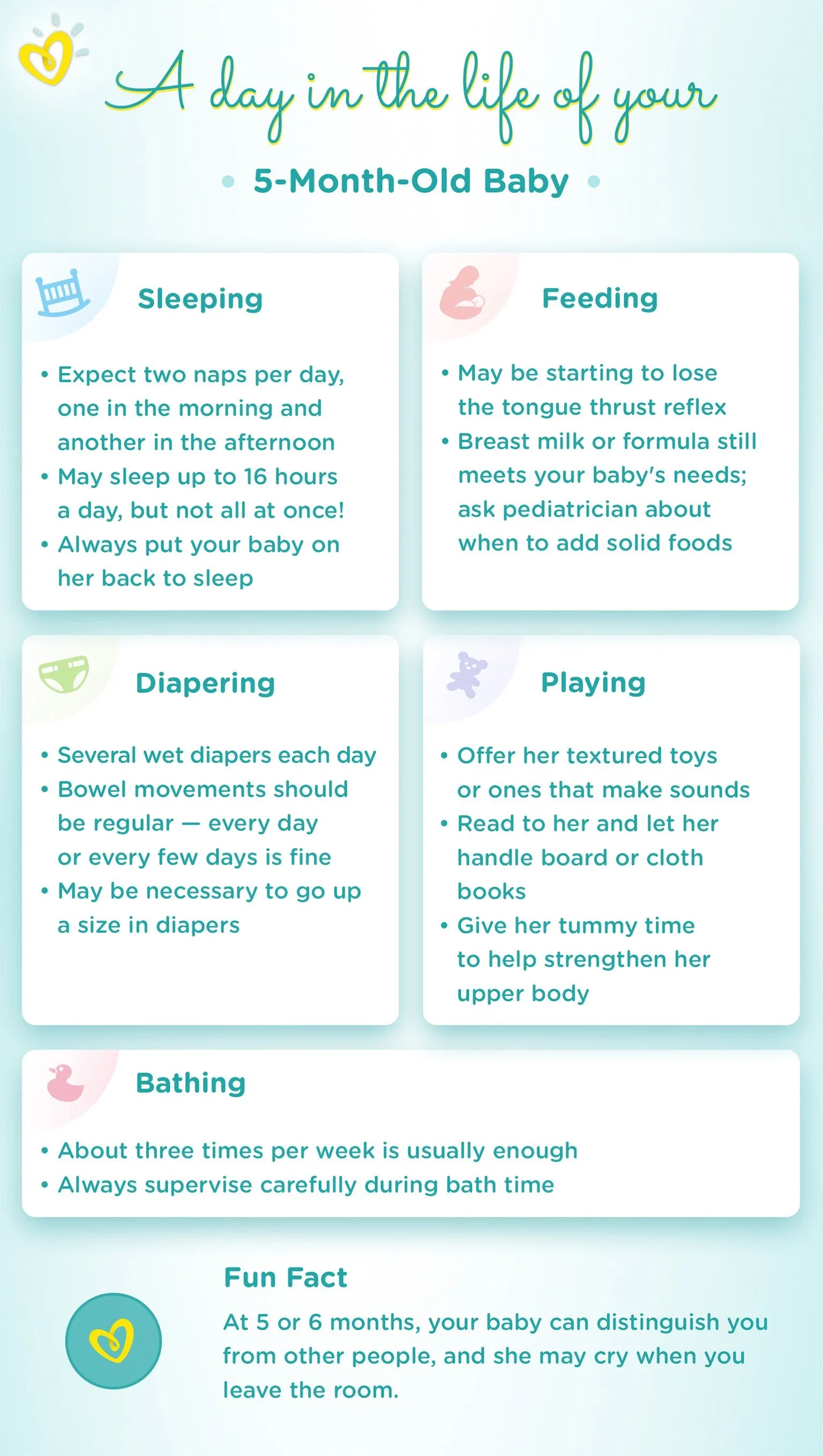Your 5 Month Old Baby’s Development & Activities
The months have flown by and your baby has been growing like crazy — she may be double the size she was at birth. It's not just her little body that is getting bigger, but her whole world, too. She may show an interest in complex shapes and patterns, and perhaps even try to babble to you in her early attempts at conversation. Enjoy the ride as you watch your little one grow and develop this month, and read on to see what exciting things your baby will learn to do during 5th month!
5 Month Old Baby Development Milestones
Let's see what exciting and sometimes challenging changes await you this month.
Growth and Physical Development of 5 Month Old Baby
Each baby is different and will develop at her own pace, but once your baby turns about 5 months old, you may notice that she's about double her birth weight. On average, babies this age will gain around 1 ¼ pounds and grow 0.8 inches in length per month. Your baby's healthcare provider will keep track of her growth using baby growth charts to make sure her growth is steady.
Senses: Your 5 Month Baby Loves Red and Blue
Your baby's eyesight keeps on improving, and by now she can see much farther than before. You might notice reds and blues are her favorites as she may prefer to look at those colours. Your little girl will probably like to stare at more complex patterns and shapes; she will find these really interesting as her sight matures, so don't shy away from showing her picture books and posters with bold and intricate patterns.
5 Month Baby Movement: Building Stronger Core Muscles
Your baby is getting stronger and she is working on building those all-important core muscles. By now, she can raise and hold her head and chest when lying on her stomach. She'll continue to strengthen these muscles as she pushes her head and chest further up. Perhaps she'll enthusiastically move her legs and rock back and forth on her tummy. This isn't just her being cute — it's how she's building the strength to eventually roll over and also to start crawling.
Personality: Your 5 Month Old Baby Gets Experimental
Babies are fast learners and each experience will teach your little one so many things. At around 5 months old, your baby will start to learn that each action has a reaction. Perhaps she will kick her mattress and notice the crib rocks, or she'll drop something and see that you pick it right up. This will encourage her to become curious and she will test out how she can influence the world around her. This may get frustrating for you as a parent — it's not fun to pick up a dropped rattle for the umpteenth time — but indulge her as long as it's safe. Make sure she doesn't play with anything she can choke on, or that's breakable, sharp, or toxic. Experimenting helps her brain develop and will also help her better understand how she can impact her environment.
As your baby's cognitive abilities expand, you'll be fascinated by her ability to soak up information like a sponge. Engage her eager mind by taking her for walks around the neighborhood, talking to her, and showing her new things. She will love books with large, brightly colored pictures. You can also help her develop her language skills by calling out the names of the new things she sees. She may even babble back as if she has understood you. When you talk to her, pause for a second to let her give you her “answer.” These are your first, early conversations with your little one, and although she may not make much sense at 5 months old, isn't it lovely to communicate with your baby? The more you do it, the better she becomes, and she'll be ready to say her first words in a few months' time.
How to Support Your 5 Month Old Baby’s Development
Your baby has been working hard to develop strong neck and shoulder muscles. Over the coming months, she will use these muscles to stay sitting up, roll over, crawl, and eventually walk. Continue with providing daily tummy time sessions to help your little one build up these skills. Try to do it two or three times a day if you can. As she gets used to tummy time, you can do it more often to help her gain strength and confidence. Make sure she is awake during tummy time and never leave her unattended.
Feeding Your 5-Month-Old Baby
At 5 months old, your baby may be taking four to six ounces of breast milk or formula at each feeding, or perhaps even more. She may need to eat more when she goes through a growth spurt, which can happen at any time; you may notice one when your baby turns about 6 months old. Whenever she seems hungry, follow her hunger cues and feed her on demand.
What goes hand-in-hand with feeding? Diaper changes! Give your little one best comfort at both day & night with Pampers baby products. Know more about wide range of Baby Diapers & Wipes offered by Pampers India.
How Much Sleep Does a 5-Month-Old Baby Need?
Around this time your baby will sleep 12 to 16 hours a day. This includes an extended stretch at night with perhaps only a few brief awakenings. Each baby is different but with any luck, she won’t need feeding in the middle of the night by this age. Five-month-old babies still need a couple of naps and will sleep around three to four hours during the day. If you need some help getting your baby to sleep, watch our video guide for tips on establishing a good bedtime routine.
A Day in the Life of Your 5 Month Old Baby
By now you have probably settled into a daily routine that works well for you and your baby, but here is an example for how you might choose to break up the average day:
Your 5 Month Old Baby’s Health: Tender Gums
It's upsetting to see your baby is unwell, or hear him cry when he feels pain or discomfort. You try everything as a parent to make sure your little one is safe and healthy, but there are times when he feels sick, no matter how careful you are. Some common health concerns that may affect a 5-month-old baby include:
Teething. You may notice your baby is drooling, cranky, or crying from discomfort this month. Between 4 and 7 months old, many babies start to get their first teeth. Your baby may get lucky and not feel any pain when he's teething, but he may still have swollen or tender gums. Soothe his discomfort by giving him a teething ring made of firm rubber or rubbing his gums with a clean finger. If you notice he's drooling, just wipe his mouth with a clean cloth to prevent a rash. Have a look at top 5 remedies to soothe a teething baby. If you notice your baby is in pain or is feeling irritable, turn to your baby's healthcare provider for advice.
Conjunctivitis. This is when the white of the eye and the inside of the lower eyelid become red and inflamed. Also known as pinkeye, conjunctivitis is itchy and painful, and usually lasts a week or two. Conjunctivitis is usually caused by an infection, but can also be provoked by an allergy or an irritation to something like smoke. Take your baby to his healthcare provider if you think he may have an eye infection because treatment will likely be required. Conjunctivitis is very contagious, so wash your hands before and after administering any eye drops, and if your child is in child care it may be best to keep him at home until he's all better.
FREQUENTLY ASKED QUESTIONS
Your Life as a Parent: Body Image and Self-Care
Now that a few months have passed since the birth of your baby and you're settling into a routine, you may be starting to think more about yourself. Good for you! Taking care of yourself is important, and as a new mom, it can be easy to overlook your own needs. You can get started by adding healthier habits into your daily routine. Like many new moms, you may be quite eager to return to your pre-baby figure, but it does take some time to achieve healthy weight loss after pregnancy. The key is slow and steady. Remind yourself that although your body may not look like it used to, it has done something truly incredible by giving birth to a new life. Look at how strong you are! Here are some ideas to help you feel good, or even great, about where you're at right now!
Healthy eating. Eat more fiber-filled fruits, vegetables, and whole grains; add proteins like chicken, eggs, or fish to meals; limit desserts and treats like chocolate, chips, ice cream, candies, and cookies; and watch your portion sizes.
Exercise. Once your healthcare provider gives you the all-clear, add some gentle exercise back into your daily routine. Keep in mind, you'll have to slowly work back towards your pre-pregnancy fitness levels, so aim to gradually build up your physical strength and endurance over time. Once your doctor approves, you can start off with these basic post pregnancy exercises to maintain your physical health.
Me-time. It might be challenging to set aside time for yourself, but it's important to find balance. Make plans to go to the movies with friends, or on a date night with your partner, or indulge in a spa treatment for a little well-deserved “me time.” Don't be afraid to ask for help: Get your partner, family members, or your babysitter to come to your aid when you're feeling overwhelmed or just need a break.
Checklist for 5th Month
Now that your baby is becoming more mobile, take another look at babyproofing your home to make it as safe as possible for an active baby who's ready to explore. Check out these baby proofing ideas: Remove or hide any cords or electric cables your baby could become entangled in, secure any heavy objects that could topple over once your baby starts to pull himself up on them, and babyproof edges of furniture like bookshelves and coffee tables. It could help to get on your hands and knees and crawl around your home just as your baby soon will, to see from his eye level what hazards need to be eliminated. If you have stairs it may be time to install baby gates. Track your baby’s growth using our baby growth chart.
Take a moment to look ahead to what could be coming for your little one when he's 6 months old.






